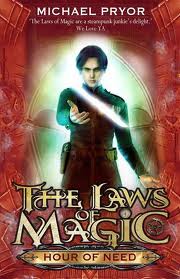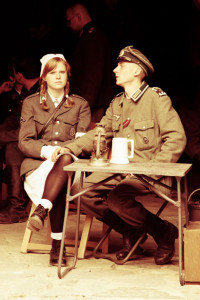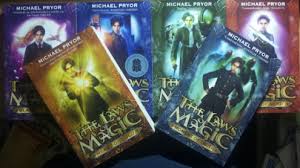Notions of genre are increasingly slippery and difficult to pin down in contemporary novels. To what extent does Michael Pryor’s Hour of Need draw on features of more than one genre? What are the effects of such intermingling of genres and especially their ideological implications?
 While as Daniel Chandler (2010) says, “Genre provides an important frame of reference which helps readers to identify, select and interpret texts.”, it can be difficult to analyse the effect of genre on aspects of narration like characterisation, or to measure ideological impact of a particular genre within a text. Some genre are closely related, mystery and detective for example, or realist and historical texts. The fact that occasionally one genre contains parts of another genre (like steampunk containing elements of science fiction, historical fiction and detective genre) make it extremely difficult to get a clear understanding of the elements of any one genre. Added to this confusion, novels rarely adhere to the conventions of a solitary genre. Hour of Need (2011) is the final novel in Michael Pryor’s The Laws of Magic series. Set in an imagined land during wartime, the protagonist, Aubrey Fitzwilliam, battles against his enemy, Dr Mordecai Tremaine, a magical super villain. Fitzwilliam’s goals: to stop Tremaine and win the heart of his love, Caroline Hepworth. While the ‘stop the villain/get the girl’ story line may appear simplistic at first glance, the many twists and turns of the plot and the use of multiple genre, make this a complex novel. Pryor incorporates steampunk, science fiction, historical fiction, fantasy, mystery, romance, detective and war genre to create a multifaceted story schema. This framework, while exciting and innovative, sees Pryor utilising oppositional stereotypes present within these genres: particularly the hero/villain dichotomy and that of gender.
While as Daniel Chandler (2010) says, “Genre provides an important frame of reference which helps readers to identify, select and interpret texts.”, it can be difficult to analyse the effect of genre on aspects of narration like characterisation, or to measure ideological impact of a particular genre within a text. Some genre are closely related, mystery and detective for example, or realist and historical texts. The fact that occasionally one genre contains parts of another genre (like steampunk containing elements of science fiction, historical fiction and detective genre) make it extremely difficult to get a clear understanding of the elements of any one genre. Added to this confusion, novels rarely adhere to the conventions of a solitary genre. Hour of Need (2011) is the final novel in Michael Pryor’s The Laws of Magic series. Set in an imagined land during wartime, the protagonist, Aubrey Fitzwilliam, battles against his enemy, Dr Mordecai Tremaine, a magical super villain. Fitzwilliam’s goals: to stop Tremaine and win the heart of his love, Caroline Hepworth. While the ‘stop the villain/get the girl’ story line may appear simplistic at first glance, the many twists and turns of the plot and the use of multiple genre, make this a complex novel. Pryor incorporates steampunk, science fiction, historical fiction, fantasy, mystery, romance, detective and war genre to create a multifaceted story schema. This framework, while exciting and innovative, sees Pryor utilising oppositional stereotypes present within these genres: particularly the hero/villain dichotomy and that of gender.
Steampunk is a “subgenre of science fiction and fantasy that includes social or technological aspects of the 19th century (the steam) usually with some deconstruction of, reimagining of, or rebellion against parts of it (the punk).” (Steampunk.com). Pryor uses this genre to build a world full of 19th century technology: field glasses, a decoding machine, “Light came from windows, the soft, yellow light of oil lamps rather than the bolder light of electricity or town gas.” (Pryor, 2011, pp. 79), zeppelins, horse and wagon, and of course steam power: “A whistle sounded as a vessel approached from upriver, steam coming from two smokestacks.” (Pryor, 2011, pp. 138). Yet he adds to this through the use of magic to find new ways of working these old technologies, ultimately to find ways to fuse chemistry and technology with magic. In this aspect of the genre, Pryor is able to successfully draw on elements of science fiction to create Dr Tremaine, the mad scientist figure (represented here as the mad magician), and pit him against Fitzwilliam, as he searches for the ultimate end: immortality.
Just as Tremaine’s character is created as immoral, focused selfishly on his own goal to the detriment of all others, Fitzwilliam is characterised as an ethical hero who considers his actions on the merits of his own strong values and morals rather than blind loyalty to an idea, person or group. He and his close friend, George Doyle, call this ‘rational patriotism’ – “Rationally following something, aware of the issues, the strengths and shortcomings…” (Pryor, 2011, pp. 117). In this way, the protagonist and antagonist are pitched as diametrical opposites. The author cleverly uses aspects of science fiction genre to engage the reader in considerations of the ethics of science and technology.
The characterisation of the protagonist is classically that of fantasy.In Taking the subject further, Margaret Rumbold says, that in fantasy literature, the “self has a unique individuality to discover…” that is “…constituted by the discovery of certain magical abilities…”, that the “…self’s growth is often determined by virtue of birth or magical powers.” and is “destined to exercise agency on behalf of others, by virtue of its superior attributes.” (1997). Similarly, Professor John Stephens says that “…quest narrative [often seen in fantasy fiction]…is characteristically built around a male career pattern which follows a structure of anxiety, doubt, conflict, challenge, temporary setback, then final success and triumph.” (1996). In Hour of Need (2011), the story is set around a male narrative that sees Fitzwilliam, gifted in logic and magic and assisted by his position of birth (as the Prime Minister’s son), acting in the best interests of all humanity as he tries and fails, but finally succeeds in bringing down Tremaine. Working within the fantasy genre, Pryor can create a duality between good and evil that positions readers to accept culturally dominant views that good is best.
 The various settings in which the story occurs often indicate the kind of behaviour to take place and add to aspects of characterisation. Clare Bradford says, habitus “the details of place and time as they are experienced by humans” can “establish expectations of certain modes of behaviour”. (2004). The opening chapter of Hour of Need, takes place in a cave in the Alemmani Mountainsoverlooking Dr Tremaine’s laboratory stronghold. Bradford goes on to say, “Place is often of great importance in children’s literature, and is frequently aligned with the process by which child characters experience identity-formation.” (2011). In Pryor’s opening scene, we are introduced to Aubrey as a desperate traitor and Hugo von Stralick, his companion, as suspicious and erratic. Their actions and appearance are constructed from within the setting they find themselves, which is described as having ‘rock walls’, ‘crags’, ‘crevices’, ‘rain’, ‘wind’, ‘snow’, ‘bears’, ‘wolves’, ‘leaf mould’ and ‘woods’. The reader experiences these characters, who look like the “Wild Man of Borneo” (Pryor, 2011), as almost animalistic, barely surviving, and this positions them to be initially cautious of both characters.
The various settings in which the story occurs often indicate the kind of behaviour to take place and add to aspects of characterisation. Clare Bradford says, habitus “the details of place and time as they are experienced by humans” can “establish expectations of certain modes of behaviour”. (2004). The opening chapter of Hour of Need, takes place in a cave in the Alemmani Mountainsoverlooking Dr Tremaine’s laboratory stronghold. Bradford goes on to say, “Place is often of great importance in children’s literature, and is frequently aligned with the process by which child characters experience identity-formation.” (2011). In Pryor’s opening scene, we are introduced to Aubrey as a desperate traitor and Hugo von Stralick, his companion, as suspicious and erratic. Their actions and appearance are constructed from within the setting they find themselves, which is described as having ‘rock walls’, ‘crags’, ‘crevices’, ‘rain’, ‘wind’, ‘snow’, ‘bears’, ‘wolves’, ‘leaf mould’ and ‘woods’. The reader experiences these characters, who look like the “Wild Man of Borneo” (Pryor, 2011), as almost animalistic, barely surviving, and this positions them to be initially cautious of both characters.
The laboratory setting within mad scientist, Tremaine’s estate implies a level of horror in the actions of Tremaine that took place there prior to Aubrey and Hugo entering the property, but that are not directly witnessed. It is the use of the mad scientist stereotype coupled with the setting of a laboratory that enables the reader to imagine the horrors that Aubrey alludes to when cautiously investigating the building. It was in this setting that Tremaine was earlier seen to have “grinned maniacally”, further characterising him as crazed. This setting additionally helps to set up the dichotomy between good and evil that is carried through the novel and that positions readers to in line with culturally dominant views of the extremes of evil.
Historical Fiction can foster understanding of present day life by exploring sensitive issues of the past with a chronological distance between events and readers. “Historical fiction is often loaded with ideologies because authors often seek to tell stories of the past in order to provide lessons about how people in contemporary times should conduct their lives.” (Bradford, 2004). The story of the power hungry leader striving for domination is an archetypal image of evil seen in history through people like Adolf Hilter and more recently in polarised views of Muslims as terrorists through people like Bin Laden and Gidaffi. Tremaine is a super villain, characterised as the ultimate evil and modelled on key political figures of the Crimean War and the First and Second World Wars.
While steampunk is a relatively new genre, its use in Pryor’s novel produces ideologies relating to gender which are suited to a time past, that of the Victorian or Edwardian era. This is perhaps one of the limiting aspects of this genre, how to be true to gender norms of history yet build a gender equality that suits modern times. Pryor’s female characters are, to some degree, representations of 19th century female characters with implications for male and female readers. Ursula Le Guin says, “The deepest foundation of the order of oppression is gendering, which names the male normal, dominant, active, and the female other, subject, passive. To begin to imagine freedom, the myths of gender, like the myths of race, have to be exploded and discarded.” (1993). Pryor’s female characters, despite being capable and strong, are also portrayed as helpless and exotic. Whenever Aubrey speaks of his mother, he refers to her by the title of ‘mother’, ubt whenever her own exploits are being discussed, she is referred to as Lady Rose. There is a clear distinction between the woman who is the caring mother and the woman who is active in the community. Aubrey, in this way, can love his mother and feel a need to protect her, and yet respect her worldly pursuits and successes. “His mother actually cried? Aubrey grimaced.” (Pryor, 2011, pp. 62).
While female characters may be respected for having strong views, they are at times treated as ‘Other’, seen as something that is different to the male characters. John Stephens discusses the “long-standing schemata for masculinity and femininity”. (1996). Within this schemata, the male is strong, unemotional, authoritarian, competitive, protective, powerful, independent, active, analytical, rational, whereas the female is beautiful, good, non-violent, emotional, soft, submissive, pleasing, caring, passive, intuitive. While Pryor attempts to subvert these stereotypes, the readers are nonetheless positioned to accept society’s dominant view of women as difficult to understand, as stubborn, as ‘Other’.
Madam Zelinka, ally of Aubrey’s, is seen as foreign, exotic. After finding Aubrey and his companion, Hugo, the first thing she does is to check on Hugo’s health before combing her hair. “von Stralick did his best to convince a skeptical Madam Zelinka that his gaunt appearance wasn’t a true reflection of his state of health, she sat on a vast leather sofa and…set about combing through her hair with her fingers…” (Pryor, 2011, pp. 57). Zelinka, despite being the head of the Enlightened Ones and an experienced operative, is shown as having a primary urge to care for others and her appearance, both attributes common to schemata of femininity.
Pryor romanticises past social movements, like the suffragette movement, in such a way as to capture the attitudes of past times. On the one hand, all the key female characters in the novel are respected for their opinions and ability to make decisions; yet on the other, all are also shown as needing protection, whose needs only play out in so far as they are in line with the protagonist’s aims and goals. In chapter 9, Caroline tells Aubrey about head of security, Craddock’s plans to utilise women (including Caroline and Lady Rose) in the war effort, with Caroline promoting the suffragist movement at this time. Aubrey questions the timing of such a move. Caroline insists this is an old argument used to keep people in their place and asserts that “There’s never a perfect time for massive social upheaval…” (Pryor, 2011, pp. 93). In this way, Aubrey is seems to represent the status quo of social attitudes.
Like Aubrey, Caroline is an experienced Albion Security Operative; she is active in the suffragette movement and capable of self-protection, however, when she is sent to Fisherberg, the enemy heartland, Aubrey’s first reaction is a need to protect her. He thinks the scheme is “dangerous” and “preposterous” (Pryor, 2011, pp. 65) and states “I can’t accept that.” (Pryor, 2011, pp. 66), not demonstrating that he believes Caroline to be an independent woman, capable of making her own decisions. Here women are seen to be active in social change and politics, something that was quite progressive for 19th century women, but is commonplace for modern women, yet on the other hand, women are also seen as not capable and therefore needing protection, thus positioning readers to accept a view of women that has continued to dominate since the 19th century and ideally would no longer be perpetuated.
 Any war novel sees action taking place primarily on the battle field or the home front and raises themes of heroism, cowardice, the physiological impact of war and questions of mortality. Traditionally war novels followed a male career pattern and thus cater to a male readership. Hour of Need (2011) is no exception. While the first five chapters build a knowledge of the depravity of Dr Tremaine’s plan and actions, and show how this relates to Aubrey as his enemy, the remainder of the novel is concerned with the state of the war and Tremaine’s hand in this. Pryor uses war genre to pitch ideologies of good/evil, hero/super villain, victims of war, male and female roles in war, and questions of ethical conduct during wartime. The use of war as a tool in Tremaine’s plan further emphasises the immorality of Tremaine’s actions – he is prepared to kill or orchestrate the deaths of thousands of people in order to fulfil his own plan for immortality. This allows Aubrey to be portrayed in opposition to this as the hero, but also shows him as hard working and careful with a great level of determination, thus positioning readers to feel that the heroism found through hard work and behaving ethically is available to all of us.
Any war novel sees action taking place primarily on the battle field or the home front and raises themes of heroism, cowardice, the physiological impact of war and questions of mortality. Traditionally war novels followed a male career pattern and thus cater to a male readership. Hour of Need (2011) is no exception. While the first five chapters build a knowledge of the depravity of Dr Tremaine’s plan and actions, and show how this relates to Aubrey as his enemy, the remainder of the novel is concerned with the state of the war and Tremaine’s hand in this. Pryor uses war genre to pitch ideologies of good/evil, hero/super villain, victims of war, male and female roles in war, and questions of ethical conduct during wartime. The use of war as a tool in Tremaine’s plan further emphasises the immorality of Tremaine’s actions – he is prepared to kill or orchestrate the deaths of thousands of people in order to fulfil his own plan for immortality. This allows Aubrey to be portrayed in opposition to this as the hero, but also shows him as hard working and careful with a great level of determination, thus positioning readers to feel that the heroism found through hard work and behaving ethically is available to all of us.
The setting of a battlefield allows the author to build unethical behaviour into some characters – this behaviour is expected in a place where killing fellow humans is par for the course. To rise above this expected behaviour though, as Aubrey does when he does not kill the enemy (Holmland) heads of state that he transports to the frontline, shows a great level of humanity, wisdom and empathy. Pryor is able to use the setting of the frontline to explore fears and vulnerabilities of the soldiers and main characters as they all witness death and contemplate their own mortality. More broadly, the setting of war is used metonymically to show historical and political significance: Albion represents England, Holmland represents Germany and/or Russia, and Gallia represents France as empires responsible from great wars. There is an intertextuality present here that draws on readers’ understanding and knowledge of historical wars.
Mystery genre involves something strange or unknown, the solving of a puzzle or crime, or obtaining secret information; whereas, “The traditional elements of the detective story are: (1) the seemingly perfect crime; (2) the wrongly accused suspect…; (3) the bungling of dim-witted police; (4) the greater powers of observation and superior mind of the detective; and (5) the startling and unexpected denouement…” (Encyclopaedia Britannica). While clearly straying from the bounds of these two genres, Pryor does utilise aspects of each. While Dr Tremaine has a plan to gain immortality, Aubrey is unsure right to the end how he will achieve this; clues are given throughout the novel. In chapter 5, Aubrey and Hugo discover cables that blend magic with electrical engineering in all the bays in the basement of Tremaine’s estate, but do not know to what end they are there. Aubrey works out that Tremaine is possibly planning a war on multiple fronts that will join to form one great front, but cannot be sure this is what Tremaine is doing or why. Hugo finds a large rare Green Johannes stone from the distant village of Kosur in the estate house, but has no idea why it is there. Each chapter brings new clues and pieces of the puzzle as Aubrey tries to anticipate Tremaine’s next step and the plots within plots of his overall plan. Finally, in chapter 10, Aubrey and his friends discover Tremaine has mined a huge slab of Green Johannes stone and shipped it to Stalsfrieden, a Holmland city, and that he was trying to reignite Holmland passion for the war effort by having troops masquerading as Albionite solders massacre the village of Kosur.
The use of elements of detective and mystery genre position the reader to engage with the text by gathering clues along with Aubrey and trying to solve the puzzles; so the reader too can feel as Aubrey does, “as if he were managing to catch sight of the smallest corner, the barest hint, of a huge and vastly complicated map made by a master cartographer.” (Pryor, 2011, pp. 75). The reader is shown Aubrey’s use of logical, rational thought and deductive powers, along with his careful observation and thorough note taking. All of these qualities are held up as the hallmarks of the determination that leads to success, further indoctrinating readers into an understanding of what are viewed as fine skills to aspire to having.
The Romance Writers of America state that “Two basic elements comprise every romance novel: a central love story [in which] two individuals falling in love and struggling to make the relationship work… and an emotionally-satisfying and optimistic ending [in which] the lovers who risk and struggle for each other and their relationship are rewarded with emotional justice and unconditional love.” Pryor’s inclusion of Aubrey’s love interest firmly sets this novel within ideologies of heterosexual relationships, positioning readers to engage with socially dominant views of sexuality. Aubrey alludes to Caroline being one of his friends, but later he states that “Long ago he’d accepted that his mission – his personal mission to win Caroline – had gone by the board.” This clearly follows a romance genre of thwarted efforts in love. “He examined the incident from a dozen points of view, a hundred different pints of view.” (Pryor, 2011, pp. 8). It is clear that Aubrey worries himself about Caroline’s actions and words as he tries to analyse her every move. The reader is invited to view Aubrey as capable in worldly affairs, but hopeless in love.
Bradford suggests that “Narratives about relationships generally work in conjunction with narratives about individual growth or maturation.” (2004). Aubrey is self-conscious and overly protective around Caroline, the object of his somewhat clumsy affection. Aubrey is presented as a gentleman, he and Caroline have spent many weeks living in close quarters, but they are only seen to take the step of kissing when Aubrey proposes to her in the final chapter. This harking back to chivalry long gone ties closely to the steampunk genre and makes an effort to counter-balance present day morality concerned with young adult sexuality and promiscuity.
This is a challenging yet entertaining novel that benefits from a “macro-discoursal perspective, that is reading ‘top down’, and from the micro-discoursal, or reading ‘bottom up’.” (Stephens, 1992). In other words, the author utilises the readers’ prior knowledge of historical era and world events, of many genres (eg: war, romance, detective) and themes such as good and evil, along with a broad and complex vocabulary to grasp the humour created through the use of irony and pun, in order to navigate their way through the layers of meaning and the ideological positions offered. Given the use of war, mystery and detective genre, it is easy to make predications early on in the novel of what the outcome may be of the war and conflict. It is clear from the outset that no matter the setback, Aubrey will be successful in overcoming Tremaine in the end. Added to this, the use of romance genre confirms early in the novel that Aubrey will also be successful in attaining his love. This kind of assurance is only possible through knowledge of the schemata of these genres.
References:
Bradford, C. 2004, ‘Characters and genres’ in Narrative Theory and Children’s Literature, Deakin University, Australia.
Bradford, C. 2004, ‘Beginnings endings, time, place’ in Narrative Theory and Children’s Literature, Deakin University, Australia.
Encyclopedia Britannica, Inc. 2011, Britannica – The Online Encyclopedia, <http://www.britannica.com> accessed 12 October 2012.
Chandler, D, 2010, ‘Working Within Genres’, An Introduction to Genre Theory, <http://www.aber.ac.uk/media/Documents/intgenre/intgenre.html> accessed 10th October 2012.
Dictionry.com, 2011, ‘Ideology’, Dictionary.com, <http://dictionary.reference.com/browse/ideology> accessed 5th October 2012.
Hunt, P. 2001, Children’s Literature, Blackwell Publishing, USA.
International Reading Association, 2010, ‘Genre Characteristics’, Readwritethink , National Council of Teachers of English, <http://www.readwritethink.org/files/resources/lesson_images/lesson270/genre_sheet.pdf>, accessed 5th October 2012.
Le Guin, U. 1993, in Hunt, P. 2001, Children’s Literature, Blackwell Publishing, USA.
Pryor, M. 2011, The Laws of Magic: Hour of Need, Random House, Australia.
Romance Writers of America, Inc. 2011, ‘About the Romance Genre’, <http://www.rwa.org/cs/the_romance_genre> accessed 15th October 2012.
Rumbold, M, ‘Taking the subject further’, Papers, vol. 7, no. 2, 1997, pp. 16-28.
Steampunk.com, <http://www.steampunk.com> accessed 6th October 2012.
Stephens, J. ‘Ideology, discourse and narrative fiction’, Language and ideology in children’s fiction, Longman, London, 992, pp. 8-37.
Stephens, J. ‘Gender, genre and children’s literature’, Signal, January, 1996, pp. 17-30.
21×20 Media Inc., 2011, ‘SteamPunk: A List of Themes’, Writing.Com, <http://www.writing.com/main/view_item/item_id/1249132-SteamPunk-A-List-of-Themes> accessed 6th October 2012.
.
Find out more about Michael Pryor on his website: Narrative Transport, by following him on Twitter, or by finding him on Facebook.
Photo credit: Steampunkin it
Photo credit: Soldier and nurse






Pingback: The Art of Essay Writing - A Worded Life
Pingback: Essay Writing How To | A Worded Life